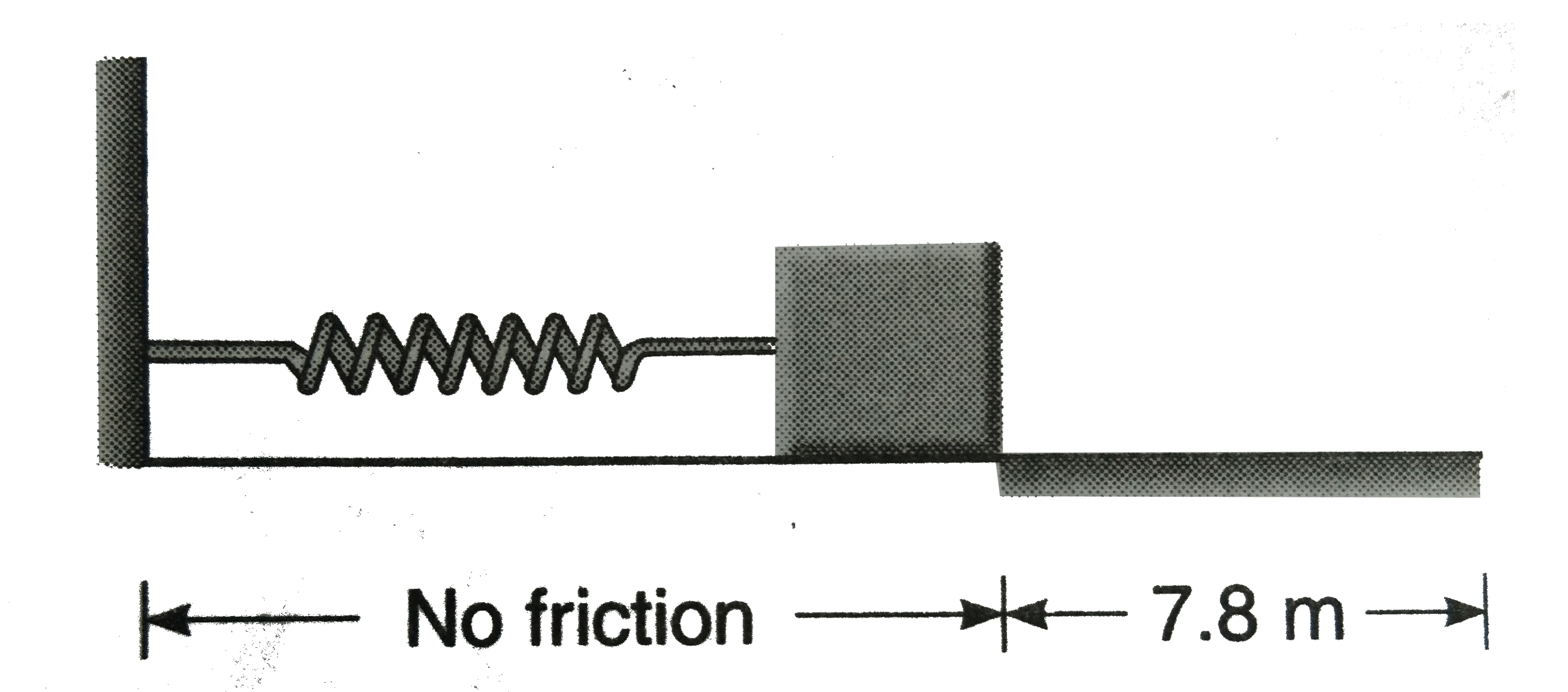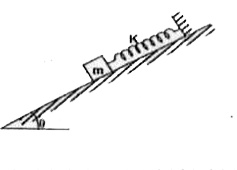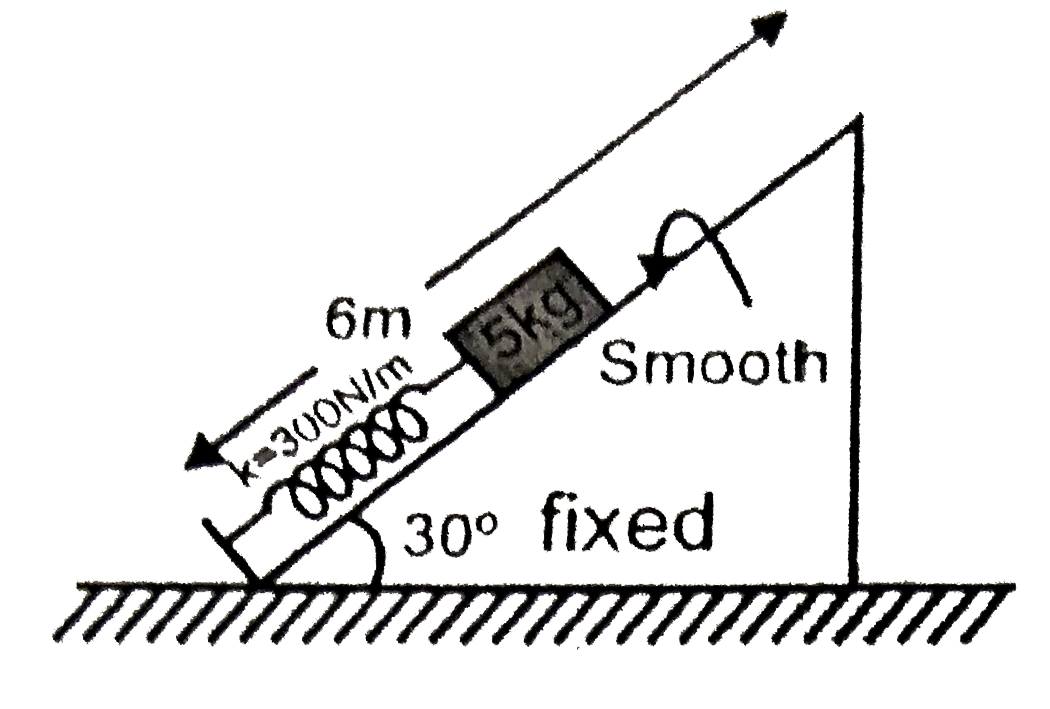In Fig. 8-78, a 3.5 kg block is accelerated from rest by a compressed spring of spring constant 640 N/m. The block leaves the spring a the spring's relaxed length and then travels over a horizontal floor with a coefficient of kinetic friction μg=0.25. The frictional force stops the block in distance D=7.8m. What are (a) the increase in the thermal energy of the block-floor system, (b) the maximum kinetic energy of the block, and (c) the original compression distance of the spring ?

The correct Answer is:(a) 67 J ; (b) 67 J ; (c) 0.46 m
Step by step video & image solution for In Fig. 8-78, a 3.5 kg block is accelerated from rest by a compressed spring of spring constant 640 N/m. The block leaves the spring a the spring's relaxed length and then travels over a horizontal floor with a coefficient of kinetic friction mu_(g)=0.25. The frictional force stops the block in distance D=7.8m. What are (a) the increase in the thermal energy of the block-floor system, (b) the maximum kinetic energy of the block, and (c) the original compression distance of the spring ? by Physics experts to help you in doubts & scoring excellent marks in Class 12 exams.
Updated on:21/07/2023Topper's Solved these Questions
- WORK, POWER, AND ENERGYBOOK - RESNICK AND HALLIDAYCHAPTER - WORK, POWER, AND ENERGYEXERCISE - PRACTICE QUESTIONS (Single Correct Choice Type)
59 Videos
- WORK, POWER, AND ENERGYBOOK - RESNICK AND HALLIDAYCHAPTER - WORK, POWER, AND ENERGYEXERCISE - PRACTICE QUESTIONS (More than one choice correct type)
10 Videos
- WORK, POWER, AND ENERGYBOOK - RESNICK AND HALLIDAYCHAPTER - WORK, POWER, AND ENERGYEXERCISE - CHECKPOINT
6 Videos
- WAVES-IBOOK - RESNICK AND HALLIDAYCHAPTER - WAVES-IEXERCISE - Practice Questions (Integer Type)
4 Videos
Similar Questions
Figure shows, a 3.5kg block accelerated by a compressed spring whose spring constant is 740N/m. After, leaving the spring at the spring' s relaxed length, the block travels over a horizontal surfce, with a coefficient of kinetic friction of 0.25, for a distance of 7.8m before stopping. (g=9.8m/s2).
 .
.
(a) What is the increase in the thermal energy of the block-floor system ?
(b) What is the maximum kinetic energy of the block ?
(c) Through that distance is the spring compressed before the block begins to move ?
View SolutionA worker pushed a 23 kg block 8.4 m along a level floor at constant speed with a force directed 32∘ below the horizontal . If the coefficient of kinetic friction between block and floor was 0.20, what were (a) the work done by the worker's force and (b) the increase in thermal energy of the block-floor system ?
View Solution
Knowledge Check
A block of mass m is attached to one end of a mass less spring of spring constant k. the other end of spring is fixed to a wall the block can move on a horizontal rough surface. The coefficient of friction between the block and the surface is μ then the compession of the spring for which maximum extension of the spring becomes half of maximum compression is .
A2mgμkBmgμkC4mgμkDNone of theseA block with mass 0.50kg is forced against a horizontal spring of negligible mass , compressing the spring a distance of 0.20m (figure). When released, the block moves on a horizontal table top for 1.00N/m. What is the coefficient of kinetic friction μk, between the block and the block and the table?
 A0.40B0.50C0.25Dnone of these
A0.40B0.50C0.25Dnone of theseIn a horizontal spring-block system force constant of spring is k = 16N/m, mass of the block is 1 kg. Maximum kinetic energy of the block is 8J. Then
Aamplitude of osciallation is 1mBat half the amplitude, potential energy stored in the spring is 2J.Cat half the amplitude kinetic energy is 6JDangular frequency of oscillation is 16 rad/s
The block in Fig. 8-12a lies on a horizontal frictionless surface, and the spring constant is 50 N/m. Initially, the spring is at its relaxed length and the block is stationary at position x=0. Then an applied force with a constant magnitude of 3.0 N pulls the block in the positive direction of the x axis, stretching the spring until the block stops. When that stopping point is reached, what are (a) the position of the block, (b) the work that has been done on the block by the spring force ? During the block's displacement, what are (d) the block's position when its kinetic energy is maximum and (e) the value of that maximum kinetic energy ?
View SolutionA block of mass m attached with a an ideal spring of force constant k is placed on a rough inclined plane having inclination θ with the horizontal and coefficient of friction μ=1/2tanθ, Initially the block is held stationary with the spring in its relaxed state, find the maximum extension in the spring if the block is released.

View SolutionA block of mass m is initially moving to the right on a horizontal frictionless surface at a speed v. It then compresses a spring of spring constant k. At the instant when the kinetic energy of the block is equal to the potential energy of the spring, the spring is compressed a distance of :
View SolutionA block of mass 5kg is initially at rest on a rough horizontal surface. A force of 45N acts over a distance of 2m. The force of friction acting on the block is 25N. The final kinetic energy of the block is
View SolutionA block of mass 5kg is released from rest when compression in spring is 2m. Block is not attached with spring and natural length of the spring in 4m. Maximum height of block from ground is :(g=10m/s2)

View Solution
